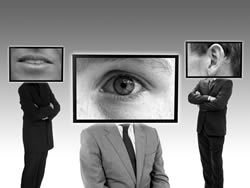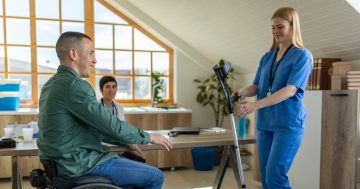Rose Eveleth* says that while new technologies can help employers monitor their workers’ every move, do the data they produce tell them anything useful?

Image: Succo
Within any large organisation, some employee teams always perform better than others — but the reasons are often murky.
In 2010 doctoral student Ben Waber embedded himself in the offices of an online travel agency to figure out what factors make a team productive.
He noted that all the employees worked in the same headquarters and sat in the same meeting rooms, but “there was something really weird” about certain interactions among them: he saw members of the most effective teams tended to eat in groups of 12, while employees from lower-performing teams usually ate in groups of four.
When Waber thought about this, it made sense.
“If you ate lunch with someone, you were much more likely to talk to them later in the week,” he says, and more communication is often linked to higher performance.
That is because people who eat with more colleagues at lunch forge more in-person connections, which they can leverage if they get stuck or need help on a task.
Many organisations are eager for useful observations like these, and new technologies — such as ever smaller sensors, cameras, microphones and radio-frequency identification (RFID) chips for identification and tracking — are allowing them to constantly and automatically monitor their employees in search of similar breakthroughs.
Waber reported his insights in his dissertation and spun them into his own company, Humanyze, which analyses organisations’ employee data in an effort to make them more productive.
This process often involves workplace sensors that read employees’ badges to track where they go, how long they stay there and with whom they interact.
Humanyze is even experimenting with sound detectors that tell it if two people standing next to each other are speaking, although the system cannot reconstruct what they are actually saying.
“I don’t care about what people are talking about,” Weber explains.
“I just want to know if people are talking.”
Employee-tracking technology is big business.
An online platform called Workplace Advisor uses strategically placed sensors and gateways to track precise, real-time space usage.
Along with calendar data, emails and other digital inputs, it also employs heat sensors to determine how many people are inside a room — so that if people are not using rooms the way they were intended, for example, it might be time for an organisation to rethink its office design.
Companies from McDonald’s to Amazon employ algorithms and passive tracking software to watch their employees, all with an eye to increasing efficiency and productivity.
It might seem intuitive that gathering such information will lead to insights that ultimately boost productivity.
But researchers who study organisations are not necessarily convinced this is so.
Surveillance does seem to change employee behaviour, but whether that improves the bottom line is less certain.
“There’s almost no evidence on it,” says Lamar Pierce, a professor of organisation and strategy at Washington University in St Louis.
And there are documented downsides to monitoring employees’ every move.
What researchers have found so far is mostly indirect evidence of a payoff, such as identifying worker characteristics that correspond to productivity.
What is missing, Pierce says, is research that links everything together, showing the cause-and-effect chain from sensor data to analysis to specific decisions that improve business outcomes.
A 2015 study published in Management Science by Pierce and his colleague Daniel Snow exemplifies the problem.
They examined the effects of a new tracking system that made it harder for restaurant employees to give out free items or skim cash off the top and found the system did, in fact, lead to less theft.
But the researchers could not identify a mechanism by which it did so.
In another field, Pierce says, that paper would not be robust enough to make it through peer review.
Given the dearth of existing evidence in the literature, however, he and Snow were able to publish it.
Even in the example of the lunch seating, the actual insight is hard to pinpoint.
Is it that reclusive, less happy workers self-select into smaller groups of four?
Or does table size itself drive performance, suggesting that moving a low-achieving employee to a 12-seater would improve that person’s work?
Waber admits that researchers do not know.
“These are always hypotheses,” he says.
“But how expensive is it to add some lunch tables and test it out?”
The lack of clear research data does not mean there is no power in tracking; it just means that its ability to increase profits remains mostly unproved.
This is partly because proof would require an extensive chain of events: an organisation would have to track its employees, analyse the resulting data, use that analysis to change the workplace and then analyse the outcome in a way that removes all doubt that it was the tracking that made the difference.
What researchers do know, however, is that the very act of observation can have an impact — and installing monitoring devices can immediately shift the way employees feel and behave.
Monitoring does not always have positive effects, however.
In one study, Michel Anteby, a researcher at Boston University, observed US Transportation Security Administration agents after surveillance cameras were installed all over their work areas.
Initially these cameras were meant to protect the workers from theft accusations.
But supervisors quickly began using the technology to catch agents for minor infringements such as dress-code violations or use of their personal phones during breaks.
As a result, the workers began to engage in what Anteby calls “invisibility practices.”
Essentially they changed their behaviour to avoid the cameras as much as possible, “getting lost” on purpose and dawdling when transferring between terminals.
These agents also reported feeling like the cameras reduced them from human beings to cogs in a machine.
They are not alone.
Amazon employees who are tracked as they “pick” items in warehouses say that being constantly timed is demoralising at best and terrifying at worst.
So, the question remains: Is the money invested in all these passive tracking systems worth it?
Right now, experts in the field of management science say the jury is out.
And the conclusive downsides should not be underestimated.
* Rose Eveleth is a writer, producer and host of the Flash Forward podcast.
This article first appeared at www.scientificamerican.com/.











